Sometimes my life is really amazing.
Almost two years ago Elise asked me about inspiration for an Art Deco wedding gown. I posted a whole week’s worth of pictures. We chatted a bit by email, she picked the most adorable modern Art Deco dress, and I sewed and sewed.
And then she contacted me again: her mother had given her a bunch of 1920s and 30s clothes from a museum clear-out. Would I like them?
Would I!?!
So I paid shipping and Elise sent me a box of gorgeous vintage things which I drooled over and meant to show you right away and just got caught up in too much other stuff and didn’t get around to photographing.
But now, months and months and months later, I have. So for the next couple of months I’ll be showing you images of the stuff Elise sent, and giving a bit of info on dates and background and stuff.
And because I’m nice, I’ll be showing you the most interesting garment first: a spangled gold on black tunic.
All the clothes probably came from a museum in Houston, Texas. The few that have labels have Houston labels. And you are thinking “what does that have to do with this tunic? It doesn’t look very Texan”
And you are right. The tunic almost certainly didn’t originate in Texan. It is almost certainly from North Africa or the Middle East.
The 1920s saw a huge interest in Egypt and the Middle East, partly because of WWI and all the soldiers who visited that area at the time, partly because of archeological finds like the 1922 discovery of Tutankhamun’s tomb, partly because of the Ballets Russes and their Eastern-inspired visual design, and partly because of a new English translation of the One Thousand and One Nights in 1923.
High Society Houston in the 1920s was incredibly wealthy, and quite avant-gard and innovative. Elise said she could just imagine a Houston socialite in this dress at a soiree at the end of the 20s. It might even have been a masquerade ball, or an ‘Oriental’ themed party, such as the 1002 Night party that Poiret was famous for.
The tunic may have been imported into the US, though the market for Middle Eastern and North African imports and textiles never reached the volume of the Far Eastern textile exports.
It’s more likely that the wearer bought the tunic on a Grand Tour, which would have included Egpyt and Jerusalem, as well as other parts of the Middle East. What an amazing souvenir!
The tunic would have been worn over a slip, probably of red silk to match the vivid red cotton the lines the neckline and the sleeve edges.
The material of the tunic itself is net: almost certainly made of cotton. The really exciting thing about the tunic though, is the metalwork. From a distance you might think it was ordinary metal pailettes sewn onto the net, but it’s not.
Instead it’s something amazing and unusual that I have never seen on any other vintage garment: little rectangular strips of soft metal, folded through the net and then wrapped around itself and crimped down.
As the metal hasn’t tarnished or oxidized in any way I suspect it actually is at least partly real gold.
It’s certainly heavy: the tunic weighs an impressive amount. Because of the weight, it’s quite fragile as you handle it. I prefer to have helpers to put it on a dressform, so that there are extra hands to support the hem and sleeves.
Once on a body or dressform the shoulders and bulk of the body support the tunic, and it’s actually very robust. Sadly, it did have some damage when it arrived from being hung for storage or displayed on the wrong dressform.
Because of the weight and fragility, and to keep the metal from catching on the net or any other material, I store this in a padded bag, with a slightly padded piece of fabric slipped through the middle, to keep the front and back from catching. With the tunic in, the padded bag gets rolled up. The padded bags are something that many museums use to store heavily beaded garments, such as 20s evening dresses, as they support the weight and protect the beads from catching.
Someday (when I find the right fabric) I’ll make a red silk slip to go under the tunic, so that it can be displayed properly.
Thank you Elise for the amazing gift!

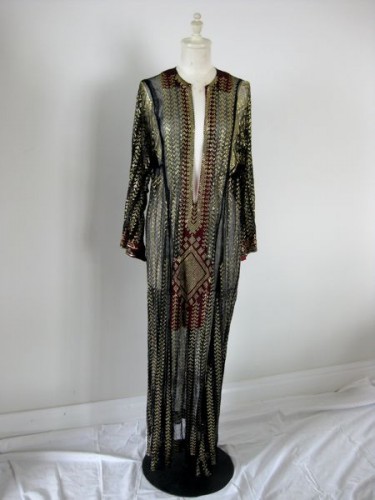
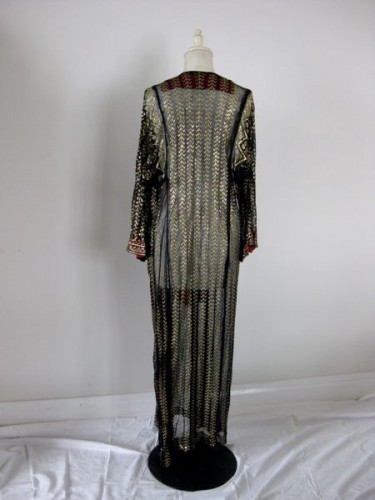

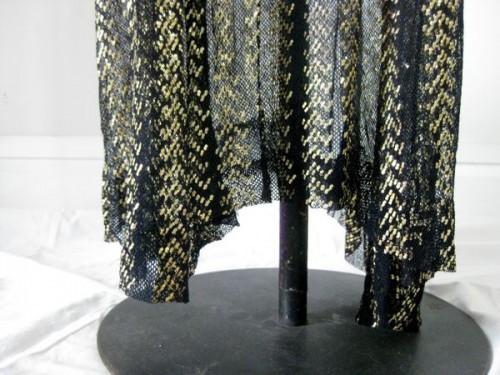



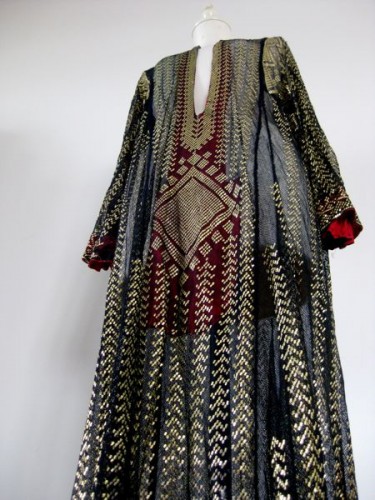
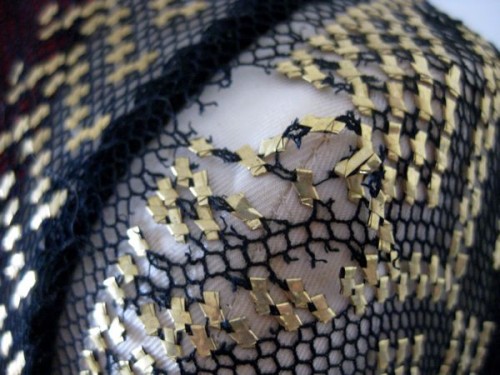
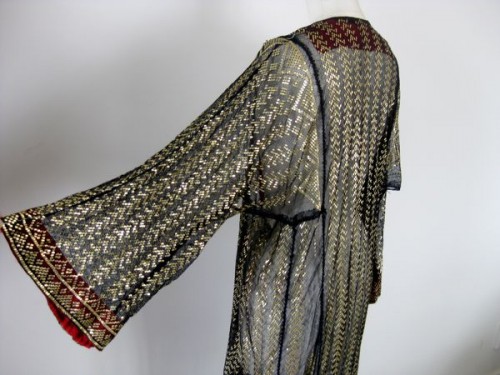
Wow! That is absolutely stunning. Thanks for sharing!
Wow. Your life truly is amazing! Thanks for sharing these pictures with us. I look forward to seeing more!
I’ve actually seen similar metalwork in silver, on a wedding shawl from the 20s at the vintage store where I work. Want me to try and grab you some pictures?
What an amazing gift to receive!! I can understand your excitement. Great analysis of it’s probable context too, you really gave colour to its past.
I got an amazing vintage/antique clothing gift once too. my friend was cleaning out her aunts house and found an antique (looks late victorian or edwardian!) black capelet. I’m making a copy of it to wear.
It’s spectacular! I want one! I can draft a pattern from the pictures you’ve put up!
Thanks for sharing, Dreamstress. It’s definitely not a kind of garment I’d associate with Texas, but then Texas is a big place with all sorts of people in it. I’m totally fascinated with how the gold strips have been applied. I’ve never seen that before. Admittedly I don’t know a lot about Middle Eastern textiles and clothing, so I wonder whether this was a common technique in that region?
Apparently, based on what Tantis posted, it is.
The fabric is called Assuit, or tulle bit telle:
http://en.wikipedia.org/wiki/Tulle_bi_telli
(same origin as the word tulle—net)
And yes, it is really, really cool stuff. I first encountered it via bellydance costumes, not entirely surprisingly. You can get modern scarves and things off ebay, but the metal is not as dense as in vintage pieces so it doesn’t drape and hang in quite the same way.
That’s an amazingly beautiful dress! 🙂
Oh wow, thank you!
Thanks for the link!
That’s beautiful! Thank you for sharing. I am fascinated by the way the metal strips are added to the net. What fine, painstaking work! And so much of it.
There is an assuit shawl in the textiles collection at TP that I accessioned back in the day but not as beautiful as this!
How fascinating! I wonder where it came from? Alas, I can’t find it in a collections search online.
Hm I think it was part of the backlog so maybe it still hasn’t been formally accessioned! There goes my legacy. Actually there might have even been two, a cream and a black.
Imagine the impression you’d make walking into a room with that on. Especially with a red slip and the light glinting off of those metal bits!
Thanks for sharing, what a stunning example , you fortunate girl! I had not seen this type of metal work before. What a treat. Looking forward to seeing the rest of the treasures.
In my last job I remember getting 3 enquiries almost in a row from members of the public with assyt shawls. It was a bizarre coincidence – like buses! Ended up becoming the resident go-to for assyt enquiries as a result…!
More interestingly, one of the last enquiries I dealt with was for a wedding train made from a white assyt shawl, apparently edged (presumably for the wedding!) with pearls. Which sounds rather awful actually…!
What a beautiful garment, thank you for sharing. Thanks too for the storage information: by a weird coincidence I bought a length of 1920s assuit at a vintage fair today,and was wondering how best to store it.
Oh how lucky! What does it look like?
If your assuit is just a flat length of fabric, an easy and effective way to store it is to roll it on to a tube along with a length of unbleached cotton muslin (so that the UCM protects every layer from the one below it).
Hahahaha–and to think of how I packed everything up to mail to you–and worse–how my own mum packed everything up to mail to me!
In fact, I knew better than to completely lay out the piece, so I had never seen it in its entirety. Beautiful thing! I can still imagine a wealthy Houston lady wearing it as a lark, but you are right that it probably came from a grand tour. Interesting note: most of the ‘better’ homes I visited in the area all had pieces from various relatives’ tours.
I have one more note for you. You may know that I’m getting a lot of my memories back, and one thing that I remember is that many ladies at the time in Texas would have not gotten garments from stores (unless they traveled to New Orleans or to New York), but rather they would take pictures or drawings of the newest fashions, and had a dressmaker copy them, just like the 1810s!
I am so so glad that the pieces found a home and a use for you! As much as I love vintage clothes, I can’t DO anything with them, like you can. And not only do you DO things with them, you make so many people happy–and more educated–in the process. Thank you for breathing these clothes new life!
Ooooh, how amazing! I hope it can someday be worn in a talk of yours.
I’d love to talk about it, but alas, I don’t think it is quite robust enough to be worn for a talk.
What a treasure!!!!!!
And thanks, Tanit Isis, for the more background info.
If you sew a slip to go with it, you could at least display it on a manequin on a talk, could you not? That would be next best thing to wearing it.
It definitely is from the Middle East, and probably Egypt! I used to live in Egypt and Sudan, and I saw some antique work like that in some markets in Sudan. (There’s a tribe called the Rashaida that would make ornate veils with metal work like that.)
The name “assiut tunic” comes from a city in Upper Egypt named Assiout. It surely does look Egyptian (there are still modern equivalents that have a similar shape, though I’ve only seen them in much cheaper materials). It’s gorgeous!
Hi – Check out “Cloth of Egypt” upcoming book on Assuit: http://us1.campaign-archive2.com/?u=19eca14e06b98b8629dcc70aa&id=7727aa6e6f&e=eb3030dbe2 . Dawn Davina Brown has thoroughly researched and written on the fabric history, care, repair, cleaning, etc – it’s coming out by the end of this year.
Best,
Sherri